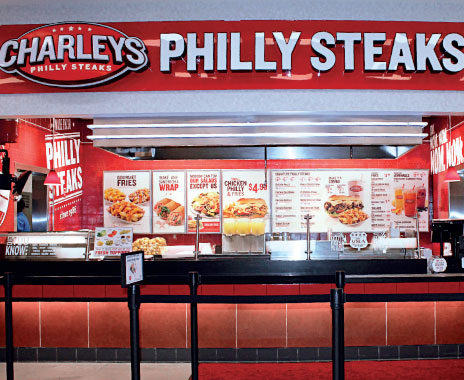Food courts present an array of choices and flavors in quick-service and grab-and-go formats, and consumers have come to expect competitive variety in spaces like malls, airports, and transportation centers. But experts say brands positioned in food courts won’t attract attention simply by having the real estate. Just as with standalone units, brands must market what differentiates them, seek spaces that align with their offerings, and meet the expectations of diners seeking convenient service.
Anita Blackford, senior vice president of leasing for the Metrocenter Mall, a super-regional shopping destination in Phoenix, says differentiated brands serve consumers best and are critical to the profitability of the entity that leases the space.
“It would be hard to justify adding a food type we already have because it would just hurt both brands,” she says. “In some instances, you might see similar things, like a Subway and a Charleys, which are both sandwich places but different enough to make sense.”
Though food courts, like many nontraditional venues, have the advantage of a captive consumer population, a brand can’t simply wait for business to come, says Jim Novak, a multiunit franchise operator for Charleys Philly Steaks. With stores in three malls—including a unit in Phoenix’s Metrocenter—and one strip center, Novak is familiar with both traditional and nontraditional spaces. He says the laws of attracting business between the two are not all that different.
“Don’t expect people to come to you simply because you are in the mall,” he says. “There are plenty of brands we’ve seen whose names aren’t there anymore because they didn’t make it a positive experience. You have to stand out. ”
In terms of competition, there are benefits and drawbacks to being in a group of like-minded businesses serving the same audience, operators say. Most food-court management companies offer standard exclusivity clauses, so chances are good the product mix will not include a directly competitive food type, says Stuart Thompson, spokesman for Regina Pizzeria, a Boston-based brand with units mostly located in malls. “If someone wants pizza, you’re going to get that person,” he says.
One Regina Pizzeria sits among nearly 50 competing quick-serve choices in Faneuil Hall Marketplace in Boston, one of the largest food courts in America.
Novak says the food-court setting is different from a traditional restaurant in many ways, but in the end, “it is still food, and [it’s] basically customer service that makes a difference between success and failure.”
Product mix and demographics are also top of mind for food-court operators, Thompson says. “If you have a high-end demographic and you have all quality properties, they will tend to compete well with each other,” he says. Over time, though, some food courts get out of balance. A good management company will strive to keep a product mix that matches demographics and economics, he adds.
As many food courts operate seven days a week, the food mix and storage capacity can be a challenge. Some settings have storage nearby while others don’t, Novak says. “You learn to use every inch, from floor to ceiling,” he says. “You watch your ordering and always are prepared.”
Novak says operators can look at the sales of a mall by the square foot, as well as food-court sales, to see how profitable a restaurant could potentially be. The broader market should also be investigated, he adds; higher-income areas might have fewer people who turn to the food court, who instead opt for full-service restaurants.
Sometimes, those full-service restaurants might be in the same mall as the food court, Thompson says. That’s due in part to a growing trend of adding lifestyle dining to malls, something that’s “changing the food-court dynamic dramatically and should be an important criteria in evaluating a food-court setting,” he says.
Another change on the rise is the addition of more local food brands, Blackford says. “We like to see a blend of national brands, but we try to find the really great local flair as well,” she says.
Local brands are popular in standalone food-court establishments like Boston’s Faneuil Hall, where Regina Pizzeria is one of several chains founded in the city. For the traditional mall food-court setting, Blackford says, mall executives will work with brands to help them make court-specific decisions and food preparation plans that will meet the fast service time demands.
“It sounds elementary, but it’s really true. They have to be clean and fast,” she says. “We always ask brands how they do business. What’s their process? How will they and can they meet the 5–10 minute service window? It might mean they change their processes some.”
Blackford says a good management company will partner with tenants, offering marketing support and more. For instance, Novak’s Charleys store opens at 8 a.m. to capture the mall’s early-morning traffic. To support marketing efforts, Blackford says, mall executives “offer to increase [our tenant’s] messages through our channels so customers at the other end of a big mall will know what we have in the food court. We think our food court is as important as major department store anchors.”










